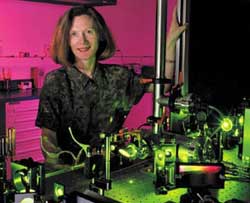Margaret Murnane
Margaret Murnane has a fascinating story to tell - if you can keep up with her. In a sense, Murnane is the fastest person who ever lived. An optical physicist at the University of Colorado, she builds lasers that flash for ten quadrillionths of a second - the fastest things that humans have ever created.

Margaret Murnane and Henry Kapteyn

Margaret Murnane, 2000 Fellow recipient from the Macarthur Foundation. Photo by Bill Sallaz.
Murnane grew up in the countryside of Ireland. Her father, an elementary school teacher, encouraged her love of math and science by giving her math puzzles, and then rewarded her with chocolates if she solved them. Her high school offered physics, which was unusual for a girls' school in Ireland. "Physics was my worst subject in high school," Murnane said. But she had known since she was nine that she wanted to be a physicist - she said it gave her the "excitement of discovery." She went on to college in Cork, Ireland, and graduate school at the University of California at Berkeley.
At Berkeley, she studied with a young professor who had just started to work with lasers. Lasers are essentially devices for amplifying light - the light that comes out is a bright beam that is highly directional. "I love working with lasers because they're so appealing visually," Murnane said. "The kind of lasers I first worked with were very beautiful red, crimson and orange colors."
In her first year at Berkeley, she met Henry Kapteyn, an American graduate student. They married, and found physics jobs together first at Washington State University, and then at the University of Michigan. In 1999, they were both hired by the University of Colorado, where they now run a lab together. "It's wonderful because we really have a team," Murnane said. Their students call Murnane and Kapteyn, the two heads of the lab, "mom" and "dad.""
In the lab, Murnane, Kapteyn, and their students make lasers whose beams flash like a strobe light - except that each flash is a trillion times faster. These lasers, like camera flashes, shine strobe lights that let Murnane record some of the fastest motions in our natural world. These motions include the dance of electrons as they swarm around molecules, or as they hop from site to site in materials. Murnane builds lasers quick enough to capture the movements of even an electron. Her newest laser and x-ray beams flash for less than a femtosecond — or less than 0.000000000000001 seconds. To put that time in perspective, if ten femtoseconds felt like one minute, one minute would feel like the age of the universe.
Murnane loves living in Colorado. "In ten minutes, you can be in the foothills of the Rockies," she said. She enjoys biking, skiing and hiking, and she has traveled throughout the world with her husband. She still enjoys the thrill of discovery in physics. "It's not easy to predict the outcome of our experiments," she says. "Nobody else knows the answer, so it's up to you."











